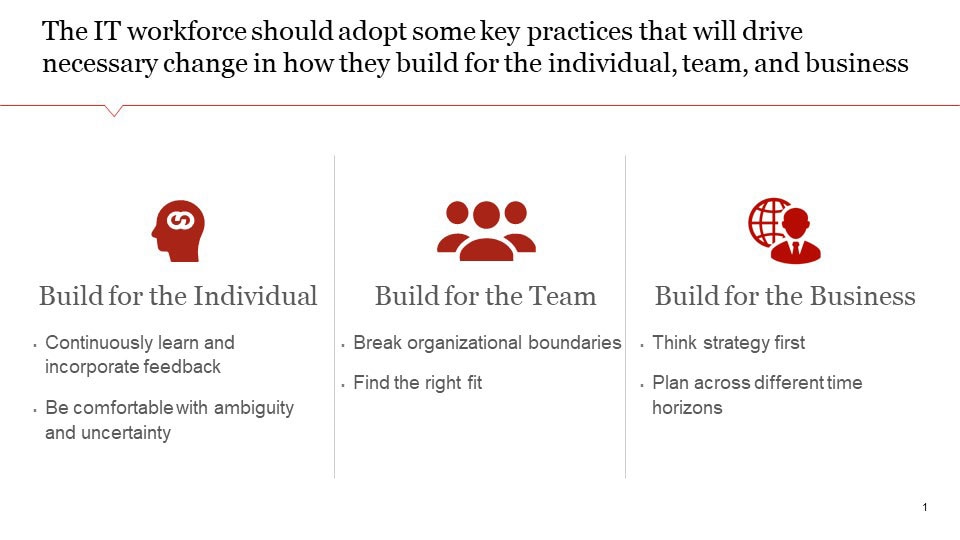Key attributes of a digital-ready IT workforce
March 01, 2019
Rapid acceleration and technology changes are reshaping the Workforce of the Future, and both expectations and opportunities for IT have increased. IT has the unique opportunity to position itself as the catalyst that shapes and drives digital-driven competitive advantage. Meanwhile there is a baseline expectation that IT must operate with agility, resilience, cost-transparency, and reliability at scale. The IT workforce will need to balance between both traditional and more strategic delivery modes and adapt to new ways of working.
As described in “The future of your company depends on next-gen IT talent,” IT roles are changing and 5 role archetypes will redefine the next-generation IT workforce. As the next-generation IT workforce embraces these new role archetypes, they should adopt some key attributes that will drive necessary change in how they build for the individual, the team, and the business.
Building for the individual
To drive the digital agenda, individuals within an IT organization should start with their own journey and growth. A recent strategy+business article describes how feedback enables individuals to improve, adapt, and work better. Asking and incorporating feedback can help individuals within IT adapt to new ways of working and make strides in their professional and personal journeys. Through feedback loops, development plans, and self-assessments, the IT workforce can enhance not only their technical skills, but also their social intelligence, emotional intelligence, and other soft skills.
To continue to develop, individuals should be ready to take risks and be comfortable with ambiguity. The Navy Seals, for example, train their recruits to be comfortable being uncomfortable, to prepare them for what unknown lies ahead. By embracing a similar perspective individuals in IT can push beyond the boundaries of what they traditionally deliver to enable change. For instance, a large healthcare payor had a guiding principle for project leads to fail fast, test iteratively, and continuously improve. Even if a project or initiative falls short of one’s goals, there are valuable insights to be learned.
Building for the team
Digital agendas by nature tend to span functional boundaries, which makes collaboration even more imperative. PwC’s Innovation Benchmark Findings found that 64% of businesses perceive lack of collaboration between IT and business as an existing barrier to digital technology initiatives. The IT workforce should break organizational silos and behave as one team to define a digital future that links key business functions, such as finance, HR, marketing, and more. At a global consumer products company, the most effective IT business partners were extremely savvy at bringing disparate stakeholders together to solve a common problem — be it supply chain transformation, digitizing marketing or implementing a new HR system.
The best teams include a mix of talent that include both multi-modal best athletes that can shift across a variety of teams as well as specialists and experts. To add the most value to team, individuals should know where they fit best. Whether it be to provide expert knowledge on traditional IT systems, solution architecture or play a more generalist role, individuals should find what best fit their skill sets, interests, and capabilities. For example, in high performing extreme programming (“XP”) teams, roles are fungible and teams are self-organizing; individuals have interchangeable skills and are able to shift their role from functional expert to developer to tester. By building teams that blends elements of multiple archetypes, the IT workforce can fill the unique talent needs of the next-gen IT.
Building for the business
When building for the business, the IT teams should think strategy first, then figure out the processes, tools and technologies. Teams should start by defining an IT strategy that connects to business outcomes. IT cannot simply advocate new technology for the sake of new technology, or else the business risks investing in non-value add projects under the moniker of “digital.” Instead, IT should develop an understanding of business pain points, success factors and journeys in order to quantify the value of its projects for the business.
As IT and business define the strategic IT objectives, IT teams should rationalize short term and long term priorities accordingly. By planning for how initiatives can add value to the business over different time horizons, IT teams can build out the appropriate technology roadmap. Many clients have optimized project delivery planning to allow for flexibility and iteration in the short term, while delivering long term strategy and vision. Failure to effectively plan and prioritize may lead to investing in too many transitory solutions or over-indexing on too many long-term disruptive ideas that never come to fruition.
Summary
As IT becomes more integrated into the strategic fabric of the company, the roles and actions of the IT workforce must evolve in tandem. This post outlines some key attributes that can enable the shift in how the IT workforce builds for the individual, the team, and the business. Subsequent posts will continue to explore the next-gen IT, including how culture plays a role in the IT operating model of the future.
Contact us






